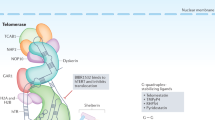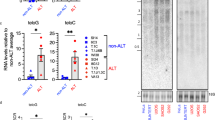Abstract
Alternative lengthening of telomeres (ALT)1 is likely to be an important target for anticancer treatment as ∼10% of cancers depend on this telomere maintenance mechanism for continued growth2, and inhibition of ALT can cause cellular senescence3. However, no ALT inhibitors have been developed for therapeutic use because of the lack of a suitable ALT activity assay and of known ALT-specific target molecules. Here we show that partially single-stranded telomeric (CCCTAA)n DNA circles (C-circles) are ALT specific. We provide an assay that is rapidly and linearly responsive to ALT activity and that is suitable for screening for ALT inhibitors. We detect C-circles in blood from ALT+ osteosarcoma patients, suggesting that the C-circle assay (CC assay) may have clinical utility for diagnosis and management of ALT+ tumors.
This is a preview of subscription content, access via your institution
Access options
Subscribe to this journal
Receive 12 print issues and online access
$209.00 per year
only $17.42 per issue
Buy this article
- Purchase on Springer Link
- Instant access to full article PDF
Prices may be subject to local taxes which are calculated during checkout




Similar content being viewed by others
References
Bryan, T.M., Englezou, A., Gupta, J., Bacchetti, S. & Reddel, R.R. Telomere elongation in immortal human cells without detectable telomerase activity. EMBO J. 14, 4240–4248 (1995).
Henson, J.D. et al. A robust assay for alternative lengthening of telomeres (ALT) in tumors demonstrates the significance of ALT in sarcomas and astrocytomas. Clin. Cancer Res. 11, 217–225 (2005).
Perrem, K. et al. Repression of an alternative mechanism for lengthening of telomeres in somatic cell hybrids. Oncogene 18, 3383–3390 (1999).
McEachern, M.J., Krauskopf, A. & Blackburn, E.H. Telomeres and their control. Annu. Rev. Genet. 34, 331–358 (2000).
Dunham, M.A., Neumann, A.A., Fasching, C.L. & Reddel, R.R. Telomere maintenance by recombination in human cells. Nat. Genet. 26, 447–450 (2000).
Jiang, W.Q. et al. Suppression of alternative lengthening of telomeres by Sp100-mediated sequestration of MRE11/RAD50/NBS1 complex. Mol. Cell. Biol. 25, 2708–2721 (2005).
Potts, P.R. & Yu, H. The SMC5/6 complex maintains telomere length in ALT cancer cells through SUMOylation of telomere-binding proteins. Nat. Struct. Mol. Biol. 14, 581–590 (2007).
Murnane, J.P., Sabatier, L., Marder, B.A. & Morgan, W.F. Telomere dynamics in an immortal human cell line. EMBO J. 13, 4953–4962 (1994).
Perrem, K., Colgin, L.M., Neumann, A.A., Yeager, T.R. & Reddel, R.R. Coexistence of alternative lengthening of telomeres and telomerase in hTERT-transfected GM847 cells. Mol. Cell. Biol. 21, 3862–3875 (2001).
Yeager, T.R. et al. Telomerase-negative immortalized human cells contain a novel type of promyelocytic leukemia (PML) body. Cancer Res. 59, 4175–4179 (1999).
Henson, J.D. . The Role of Alternative Lengthening of Telomeres in Human Cancer. PhD thesis. Univ. Sydney (2006).
Grudic, A. et al. Replication protein A prevents accumulation of single-stranded telomeric DNA in cells that use alternative lengthening of telomeres. Nucleic Acids Res. 35, 7267–7278 (2007).
Nabetani, A. & Ishikawa, F. Unusual telomeric DNAs in human telomerase-negative immortalized cells. Mol. Cell. Biol. 29, 703–713 (2009).
Dean, F.B., Nelson, J.R., Giesler, T.L. & Lasken, R.S. Rapid amplification of plasmid and phage DNA using Phi 29 DNA polymerase and multiply-primed rolling circle amplification. Genome Res. 11, 1095–1099 (2001).
Zellinger, B., Akimcheva, S., Puizina, J., Schirato, M. & Riha, K. Ku suppresses formation of telomeric circles and alternative telomere lengthening in Arabidopsis. Mol. Cell 27, 163–169 (2007).
Zhao, Y., Hoshiyama, H., Shay, J.W. & Wright, W.E. Quantitative telomeric overhang determination using a double-strand specific nuclease. Nucleic Acids Res. 36, e14 (2008).
Fasching, C.L., Bower, K. & Reddel, R.R. Telomerase-independent telomere length maintenance in the absence of ALT-associated PML bodies. Cancer Res. 65, 2722–2729 (2005).
Varley, H., Pickett, H.A., Foxon, J.L., Reddel, R.R. & Royle, N.J. Molecular characterization of inter-telomere and intra-telomere mutations in human ALT cells. Nat. Genet. 30, 301–305 (2002).
Cerone, M.A., Autexier, C., Londono-Vallejo, J.A. & Bacchetti, S. A human cell line that maintains telomeres in the absence of telomerase and of key markers of ALT. Oncogene 24, 7893–7901 (2005).
Cesare, A.J. & Griffith, J.D. Telomeric DNA in ALT cells is characterized by free telomeric circles and heterogeneous t-loops. Mol. Cell. Biol. 24, 9948–9957 (2004).
Wang, R.C., Smogorzewska, A. & de Lange, T. Homologous recombination generates T-loop-sized deletions at human telomeres. Cell 119, 355–368 (2004).
Pickett, H.A., Cesare, A.J., Johnstone, R.L., Neumann, A.A. & Reddel, R.R. Control of telomere length by a trimming mechanism that involves generation of t-circles. EMBO J. 28, 799–809 (2009).
Ziegler, A., Zangemeister-Wittke, U. & Stahel, R.A. Circulating DNA: a new diagnostic gold mine? Cancer Treat. Rev. 28, 255–271 (2002).
Tsang, J.C. & Lo, Y.M. Circulating nucleic acids in plasma/serum. Pathology 39, 197–207 (2007).
Bryan, T.M., Englezou, A., Dalla-Pozza, L., Dunham, M.A. & Reddel, R.R. Evidence for an alternative mechanism for maintaining telomere length in human tumors and tumor-derived cell lines. Nat. Med. 3, 1271–1274 (1997).
Acknowledgements
We thank Tumour Bank (Children's Hospital Westmead, Australia) for patient blood specimens, kConFab (Australia) for LFS-05 skin sample, P.R. Potts (University of Texas Southwestern) for MMS21 antibody, M.A. Cerone (Breakthrough Breast Cancer Research Centre Institute of Cancer Research) for C3-c16 cells, P. Crowe and R. Das Gupta (Prince of Wales Hospital) for DOS16 cells, W.-Q. Jiang and K. Perrem (Children's Medical Research Institute) for IIICF/c-10, 11, 16 and 17 cells and GM847/hTERT-3 and GM847/hTERT-6 cells, respectively, D. Spector (Cold Spring Harbor Laboratory) for EYFP-SP100 construct and L. Naldini (San Raffaele Telethon Institute for Gene Therapy) for pMD2-VSVG envelope vector, and A. Muntoni for critical review of this manuscript.
Author information
Authors and Affiliations
Contributions
J.D.H. conceived and developed the assay and wrote the manuscript. L.I.H. established the LFS-05F-24 cell line. Experiments were performed by J.D.H., Y.C., L.I.H., A.C.C., A.Y.M.A. and H.A.P. R.R.R. was responsible for all aspects of the project and edited the manuscript.
Corresponding author
Supplementary information
Supplementary Text and Figures
Supplementary Figs. 1–4 and Supplementary Table 1 (PDF 636 kb)
Rights and permissions
About this article
Cite this article
Henson, J., Cao, Y., Huschtscha, L. et al. DNA C-circles are specific and quantifiable markers of alternative-lengthening-of-telomeres activity. Nat Biotechnol 27, 1181–1185 (2009). https://doi.org/10.1038/nbt.1587
Received:
Accepted:
Published:
Issue Date:
DOI: https://doi.org/10.1038/nbt.1587
This article is cited by
-
Telomeres and aging: on and off the planet!
Biogerontology (2024)
-
Histone demethylase KDM2A is a selective vulnerability of cancers relying on alternative telomere maintenance
Nature Communications (2023)
-
Break-induced replication orchestrates resection-dependent template switching
Nature (2023)
-
Connecting telomere maintenance and regulation to the developmental origin and differentiation states of neuroblastoma tumor cells
Journal of Hematology & Oncology (2022)
-
XPF activates break-induced telomere synthesis
Nature Communications (2022)



